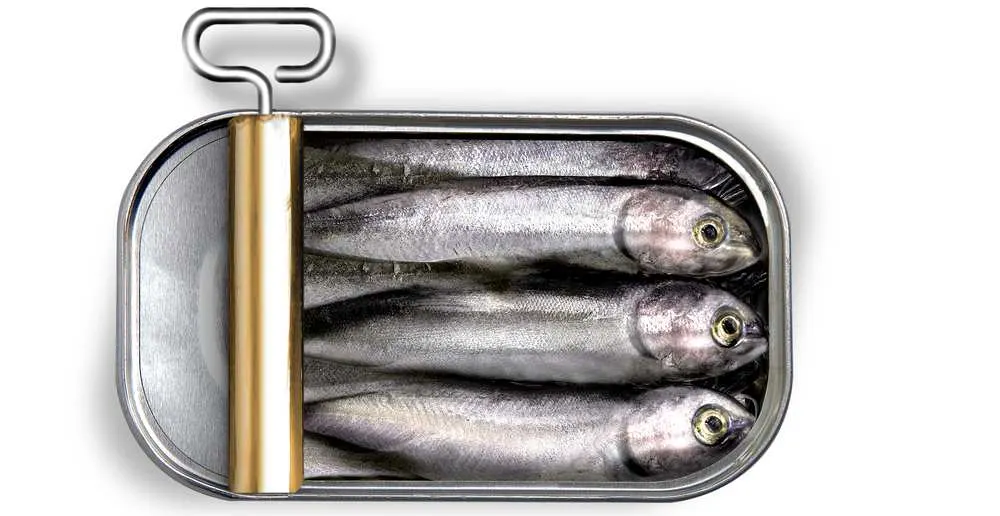It’s cold, late afternoon, and all you want is to wrap up in your blanket and watch some series. However, your dog is whining and giving you the puppy eyes look in front of your TV. But of course, Milo is hungry!
As you enter the kitchen, you suddenly realize there’s no more doggy food. The closest store is a ride away. This can’t be happening! Okay, so you’re exploring the fridge for some food your dog could eat. After a few minutes, you’ve stumbled upon canned sardines, and you’re not sure whether dogs can eat sardines or fish at all.
So, can dogs eat sardines?
Luckily, you’ve stumbled upon our article as here we are going to answer some of your burning questions. Can dogs eat sardines, and what are the risks? Are there any health benefits? How many sardines can your dog eat if he can at all? Before you crack open the can, read our article first!

Why Is Fish Good For Canines?
Fish meat is actually a great addition to your dog’s diet. It is rich in omega-3 fatty acids, vitamins, protein, and minerals such as calcium, niacin, and selenium.
Why are omega-3 fats so healthy for dogs? Well, omega-3 is a very powerful supplement that you should consider adding to your dog’s diet.
Omega-3 fats strengthen the immune system and help with the following:
- Brain development in puppies
- Reduced inflammation
- Increased ability to fight cancer
- Benefit heart health
- Strong muscles and bones
- Shiny fur
- Healthy skin
- Reduced anxiety, depression, and hyperactivity
- Treats canine arthritis and kidney disease
- Healthy eyes
- Healthy cardiovascular function and regulated cell activity
After this list, who wouldn’t want to give their dog some delicious fish meat, right? While there are a lot of health gains, you need to keep in mind some important things. For example, don’t choose a fish from the Pacific ocean because of the radiation concerns.
Unfortunately, all fish contain some heavy metals and toxins because our oceans, rivers, and lakes became heavily polluted. However, you can always choose small fish that feed only on phytoplankton and not other fish that contain more toxins.
Things To Watch Out For
Maybe you’ve already read our article about tuna consumption in canines. If you haven’t, you can check it here. First off, dogs can eat some marine food and most of the fish. The main two things you should be aware of are the species of the fish and the preparation method.
The most vital things to watch out for when feeding your dog seafood are:
- Mercury levels
- Fishbones
- Sodium levels
- Cholesterol levels
Let’s further explain each one:
1. Mercury Levels
Mercury is present in our oceans as well as lakes and rivers and enters through industrial waste. It accumulates in fish and aqua life over time. The bigger the fish and the longer its lifespan, the higher the mercury levels in its tissues will be.
Furthermore, feeding your dog every day with fish that has higher mercury levels could lead to mercury poisoning in canines.
Some of the symptoms are:
- Tremors;
- Vomiting blood;
- Bloody or watery diarrhea;
- Loss of feeling in paws;
- Kidney damage
- Inability to urinate;
- Hair loss;
- Anxiety or nervousness;
- Loss of vision
Mercury poisoning could be fatal for your puppy, so contact your vet immediately if you notice any of the signs above.
2. Fish Bones
The second thing why fish could be dangerous to your pooch is fish bones. Generally, bones, fins, tails, and heads should not be served to dogs. You should always clean the fish first from bones before giving it to your puppy.
Fishbones can damage the digestive tract and internal organs and cause your dog to choke. If you notice your pup drooling too much, they’re probably choking on a bone.
3. Sodium Levels
Fish is naturally high in sodium levels, and too much sodium can be very dangerous to your dog. Eating too much salty food can make your pup thirsty, and that could cause him to drink too much water, leading to bloat or sodium poisoning. It can also lead to high blood pressure, heart difficulties, etc. Bear in mind that dogs should eat 0,25 – 1,5 gr of salt per 100 grams of food daily.
4. Cholesterol Levels
High cholesterol levels in some fish can be difficult for dogs to digest. High cholesterol levels in canines are a condition called hyperlipidemia and can lead to many health issues, such as pancreatitis.
In the end, some fish are safe for your dog to eat, but don’t forget that moderation is necessary. Fish and other marine food shouldn’t make up most of their diet but should instead be given occasionally.

Can Dogs Eat Sardines?
The answer to your question that you’ve been waiting for is – yes, dogs can and should eat sardines! Sardines are not toxic to dogs in any way and have a lot of health benefits to offer.
Not only are they rich in omega-3 fats, but they’re also packed with many minerals and vitamins. Furthermore, sardines are a great source of protein and contain coenzyme Q10, which is excellent for dental health and neural development.
However, like any other food, sardines should also be given in moderation and not every day. Also, you should pay attention to which sardines you’re choosing for your pup. The best option is sardines packed in water and not oil or with added salt. Moreover, choose the wild-caught ones to avoid any possible harmful additives or toxins.
Avoid sardines that are packed in:
- Oil (sunflower, soy, corn, or other oil)
- Ketchup
- Brine
- Other sauces or spices
Nutritional Value Of Sardines
Sardines or so-called pilchards are small fish from the herring family. These fish can be found in Mediterranian, Pacific, and Atlantic seas. Sardines are usually used as fishing bait and can most often be found in cans on our grocery stores’ shelves. You can prepare sardines in several different ways (pickled, smoked, grilled sardines).
Sardines are highly perishable food, and that’s the reason why they are most often found canned. Also, sardines feed on plankton only and not other fishes. Therefore, they don’t contain the high mercury levels that other fish do, like tuna.
Nutritional Value Of Sardines
| Calories | 208 |
| Total fat | 11 g |
| Saturated fat | 1,5 g |
| Polyunsaturated | 5 g |
| Monounsaturated | 3,9 g |
| Cholesterol | 142 mg |
| Sodium | 505 mg |
| Potassium | 397 mg |
| Protein | 25 g |
Vitamins And Minerals
| Vitamin A | 2% |
| Vitamin D | 48% |
| Vitamin B-6 | 10% |
| Calcium | 38% |
| Magnesium | 9% |
| Cobalamin B12 | 148% |
| Iron | 16% |

Health Risks
As you can see, sardines are packed with all the good stuff, and they offer a lot of health benefits for you and your dog. However, you need to watch out for cholesterol, fat levels, and sodium levels.
- High cholesterol and fat levels can lead to many health problems, one of which is inflamed pancreas or so-called pancreatitis. Another issue with seafood, in general, is sodium levels, as we’ve already mentioned above.
- High sodium levels can cause sodium poisoning or lead to a condition called bloat due to excessive water intake. High sodium levels can also cause kidney failure, high blood pressure, heart problems, and so on.
Hence, always watch out for these three things when feeding your dog any fish food. You can check the label on the product to find the needed information and follow the chart we’ve included in this article.
Caution: Feeding too many sardines can cause the following:
- Diarrhea
- Vomiting
- Obesity
- Diabetes
- Gas
- Pancreatitis

How Many Sardines Can Your Dog Eat?
A little goes a long way with sardines as they’re nutrient-dense. One small sardine contains 25 calories, so make sure you’re feeding an appropriate amount. Feeding too many sardines can lead to digestive issues, weight gain, and, eventually, obesity.
| 5lbs or less | 2 sardines or ¼ can | Every few days |
| 6-15 lbs | 4 sardines or ½ can | Every few days |
| 16-25 lbs | 5 sardines or ⅝ can | Every few days |
| 26-50 lbs | 8 sardines or 1 can | Every few days |
| 51 or more lbs | 14 sardines or 1 ¾ can | Every few days |
We always recommend you start introducing new foods slowly to allow your puppy to adjust. Start with small portions and gradually increase the quantity. Every dog is different, and yours might not even like the taste of sardines. That’s fine, and you shouldn’t force him.

Benefits Of Sardines For Dogs
Sardines can positively impact your dog’s health, and here is why:
- Skin And Coat Health: Omega-3 fatty acids provide healthy skin and coat. Omega-3 can also reduce any kind of inflammation, redness and minimize the itching from allergies.
- Mobility: Large breeds or older dogs often suffer from persistent hip and joint pain, which limits their movement. Sardines can reduce inflammation and remove the pain almost entirely if fed regularly. They also contain adequate amounts of phosphorus and calcium, which support bone health.
- Brain Function: Sardines contain omega-3 fatty acids, and one of the three included is DHA. This fatty acid is vital for eye health and cognitive function. DHA is especially crucial for puppies and older dogs as it supports growth and minimalizes the aging signs.
- Heart Health: Coenzyme 10 or so-called Ubiquinol is an antioxidant that is usually present in your dog’s body. Boosting coenzyme 10 levels with sardines can support heart function and help with an existing congenital issue.
- Digestion And Organ Function: Sardines are rich in protein, and they contain all the essential amino acids that your furry-friend needs. These nutrients support digestion health and proper organ function. What more can you ask for? Open up a can of sardines, and treat your dog!
Learn More: What Can Dogs Eat? A Comprehensive List Of Dog-safe Foods

